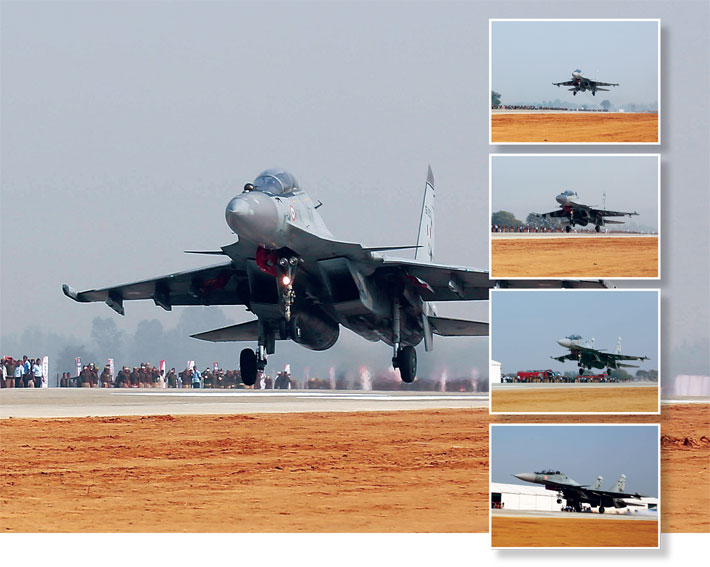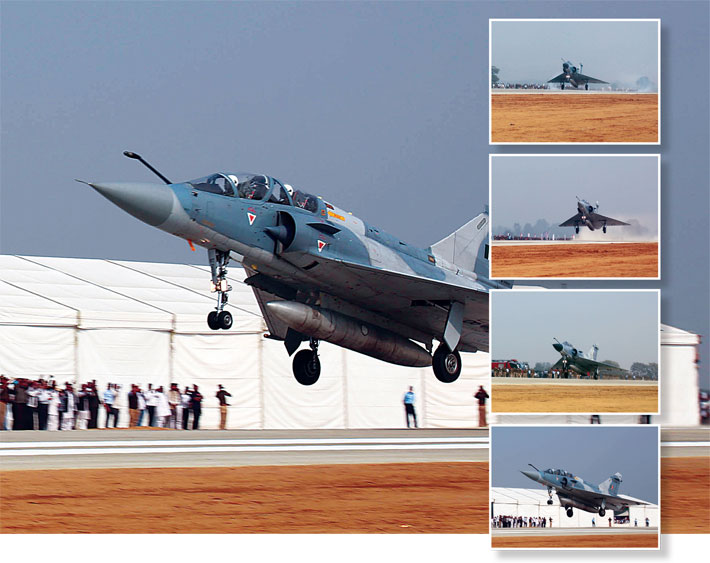INDIAN ARMED FORCES CHIEFS ON
OUR RELENTLESS AND FOCUSED PUBLISHING EFFORTS

SP Guide Publications puts forth a well compiled articulation of issues, pursuits and accomplishments of the Indian Army, over the years

I am confident that SP Guide Publications would continue to inform, inspire and influence.

My compliments to SP Guide Publications for informative and credible reportage on contemporary aerospace issues over the past six decades.
Landing on Highways
An efficiently managed model wherein designated landing strips on highways in the proximity of operational airbases are available during the war will have a force multiplier effect

Simulated Landing: Su-30MKI fighter aircraft landing at Agra-Lucknow expressway

Alternatives for Emergency: Mirage 2000 combat aircraft touches down the Expressway
November 21, 2016, was indeed a red-letter day not only for the Indian Air Force (IAF), but for the Government of Uttar Pradesh (UP) too, as it was on this day that it chose to inaugurate in grand style and in a manner that was unique, the newly built 302-km-long greenfield expressway, India’s longest six-lane highway that connects the historic city of Agra with the state capital Lucknow. The event is regarded as unique as a highway which is normally meant for vehicles to ply on, was inaugurated by a fleet of six combat jets of the IAF! Nowhere in the world has the commissioning of infrastructure for surface transport ever been carried out by the flying machines!
The IAF to the Fore
Three Mirage 2000 and three Sukhoi-30MKI fighter aircraft of the IAF carried out simulated landings on the 3.3-km stretch of the highway that is designed to serve as a runway for landing of military aircraft during war in case the runways at the IAF airfields in the vicinity are bombed by enemy aircraft and put out of action. This portion of the Agra-Lucknow expressway has been specially constructed to serve as a runway for military aircraft to operate from. It has a reinforced concrete surface of appropriate strength and with the required markings to guide fighter aircraft during landing and take-off. The technical aspects of the expressway meant to serve as a runway were overseen by the IAF so as to create the appropriate facilities and conditions for it to operate its fleet of combat or transport aircraft when required during war if the conditions so demand.
THE USE OF HIGHWAYS AS EMERGENCY LANDING STRIPS FOR MILITARY AIRCRAFT AS A CONCEPT IS NOT NEW
One after another the six fighter aircraft made their approach on the portion of the highway that was designated as the runway and immediately after the main wheels came in contact with the surface of the highway, the pilots revved up the engine to maximum power for the aircraft to get airborne again and then proceeded to land at their parent bases. All facilities such as air traffic control and firefighting, rescue services and medical facilities were provided by the IAF. The highway was closed to vehicular traffic.
The event was witnessed by Akhilesh Yadav, Chief Minister of Uttar Pradesh, and Air Marshal S.B.P. Sinha, Air Officer Commanding in Chief, Central Command, IAF, under whose jurisdiction this area lies. There were a number other senior functionaries both from the IAF and the state government as also thousands of onlookers from the villages in the area who were enthralled by the spectacular display fighter aircraft, an event that they would have witnessed possibly for the first time in their lives.
While the inauguration of the Agra-Lucknow expressway was carried out with much fanfare and the event was meant to serve both as a political as well as a military objectives, this was not the first time that fighter aircraft of the IAF have carried out landings on a highway. On May 21, 2015, the IAF carried out a trial landing by a Gwalior-based Mirage 2000 combat aircraft on the Yamuna Expressway, the eight-lane highway that connects Greater Noida to Agra. Part of the Yamuna Expressway was cordoned off for the Mirage 2000 to land. There had been a case in the past in India of an emergency landing on a highway by a small single-engine aircraft from a civil flying club following engine failure. However, this was the first time that a fighter aircraft of the IAF had carried out such an exercise and not without purpose. The aim of the exercise was to validate the concept of using a highway as an emergency landing strip for military aircraft.
Globally A Well Esta blished Practice
The use of highways as emergency landing strips for military aircraft as a concept is not new. In fact, this concept was developed during World War II in Germany where the highways called “Autobahns” were used to land fighter aircraft. This practice did not remain confined to Germany, but spread across Europe into Sweden, Finland and Switzerland. On the other side of the iron curtain, this practice was adopted by Russia, Czechoslovakia and Poland. Other countries that have carried out this exercise are Israel, North Korea, South Korea, Taiwan, Singapore and Australia. Even in the neighbourhood in Pakistan, two highways or Motorways as these are referred to there, namely M-1 connecting Peshawar to Islamabad and M-2 running between Islamabad and Lahore, two 9,000 feet long stretch on each of the highways have been designated for landing of military aircraft for training purposes or for recovery of aircraft during war. Beginning 16 years ago, the Pakistan Air Force (PAF) has carried out training exercises involving landing of the F-7P and Mirage III fighter aircraft, C-130 Hercules tactical transport aircraft and Super Mushak trainer aircraft.
During the recent stand-off between the armed forces of India and Pakistan in the wake of the attack on Uri in Kashmir, the M-2 Motorway between Islamabad and Lahore, which a very busy corridor, was closed to vehicular traffic for the fighter pilots of PAF to carry-out landings and take-offs as a part of Exercise High Mark. However, PAF spokesman told the media that Exercise High Mark was not ordered in response to recent tensions with India, but was a part of routine training. The timing of the exercise was a mere coincidence.
AS FOR PLANS FOR THE FUTURE, THE MINISTRY OF ROAD TRANSPORT AND HIGHWAYS TOGETHER WITH THE MINISTRY OF DEFENCE IS LOOKING TO BUILD HIGHWAYS ACROSS THE COUNTRY THAT CAN ALSO SERVE AS LANDING STRIPS FOR AIRCRAFT, BOTH CIVIL AND MILITARY
The breakthrough by the IAF in its effort to adopt the international practice of developing the infrastructure and capability to use highways for limited operations by military aircraft was evidently had not come too soon.
Operati onal Paradigms
A full-scale war would normally begin with aerial action called Counter Air Operations that are meant to degrade the capability of the enemy to launch air operations. Counter Air Operations consist of sorties undertaken by deep strike combat aircraft whose primary targets are the runways at enemy airfields, aircraft on ground and supporting infrastructure. Since the runways at IAF airfields are vulnerable to similar action by the enemy air force, IAF aircraft that are airborne for missions may find that the runway is suddenly not available for use as it would punctured by craters due to bombing by enemy aircraft. It is under these circumstances that alternative landing sites on highways could be a saving grace.
Modern military transport aircraft such as the C-130 Hercules or even the C295 from Airbus Defence and Space that the IAF is to acquire shortly are capable of operating from runways of restricted length and even from semi-prepared surfaces that are not classified as regular runways. For such aircraft, landing and take-off from highways do not pose any problems as far as the operating surface is concerned. Combat aircraft, especially those in the high performance category, require landing strips of standard length to operate safely. However, for any military aircraft to operate from highways, there are certain perquisites. It needs to be understood that during war, the requirement to recover an aircraft, particularly a fighter aircraft would arise on short notice. This would be an emergency situation as a combat aircraft returning from a mission would generally be low on fuel and would not be able to remain airborne for long. It is necessary for the organisation therefore to have a welldefined and responsive system in place to activate the designated strip on the highway to facilitate recovery of aircraft in difficulty or distress. This would involve controlling vehicular traffic, positioning firefighting and medical facilities as well as air traffic control. Besides, the segments of a highway designated for use as a runway ought to have removable median and ought not to be lined with trees or other obstructions such as lamp posts. During war therefore, airbases would have to be specifically tasked to be prepared to activate the landing strip on the highway at practically a moment’s notice. A military aircraft cannot be expected to land on a highway with normal traffic flowing. The consequences of such a landing would quite obviously be disastrous. An efficiently managed model wherein designated landing strips on highways in the proximity of operational airbases are available during the war will have a force multiplier effect.
Future Plans
The experience gained in the exercises involving practice landing and take from highways will go a long way in aiding the plans by the Ministry of Defence to use highways as alternative to runways for use in emergency situations. As for plans for the future, the Ministry of Road Transport and Highways together with the Ministry of Defence is looking to build highways across the country that can also serve as landing strips for aircraft, both civil and military. Some 22 possible sites in Rajasthan, Arunachal Pradesh, Meghalaya and other border states have been identified and a committee has been constituted to oversee the exercise.





